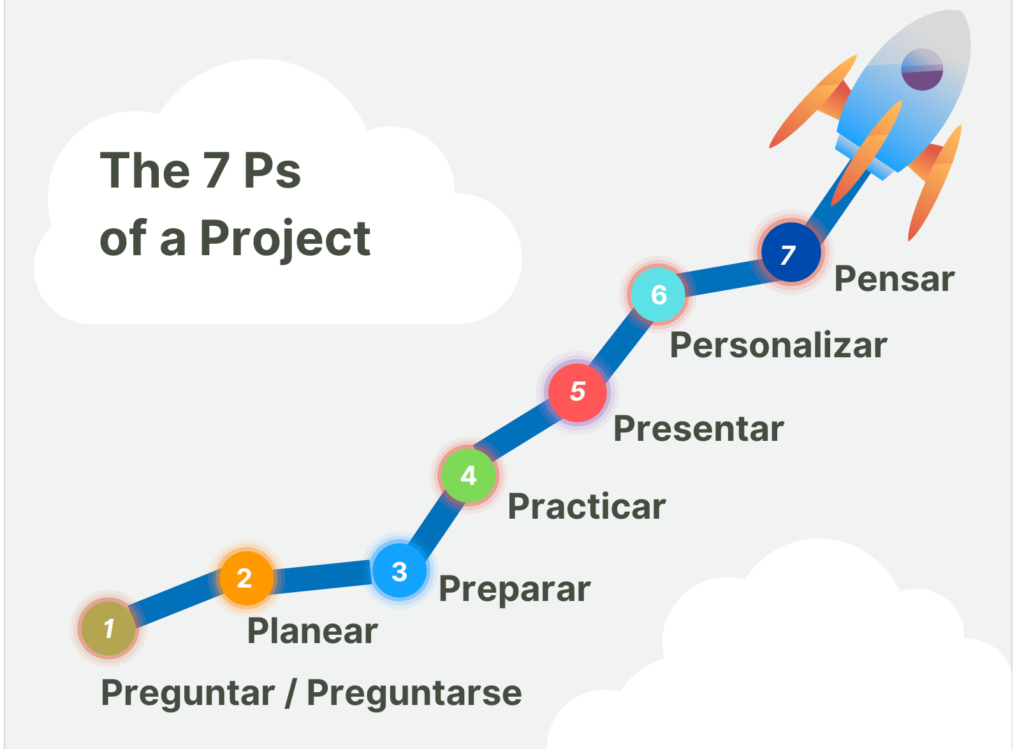“’P’ is for Project” is one of the frameworks that I usually use to help students complete a project successfully in my Spanish language classes. This framework uses words in Spanish that begin with ‘P’, guiding students to identify and follow the different steps of the process while gaining independence. In Spanish, the 7 Ps of a project include: Preguntar / Preguntarse, Planear, Preparar, Practicar. Presentar, Personalizar, Pensar.

In English, most of the names for the steps use the word ‘P’ except for the very first one, which stands for ask yourself or questions. The framework includes: ask myself/questions, plan, prepare, practise, present, personalize (give feedback) and ponder (think and reflect).
Needless to say, there are other frameworks that guide students when they do projects, such as Challenge-Based Learning, Project-Based Learning, Project-Based Language Learning, Global Competence, etc. I have used these frameworks apart from the 7 Ps for Project with good results as well.
Having a consistent path when doing projects helps students know where they are and what comes next, which lowers their affective filter. It also focuses them on the task at hand and helps them stay in the language!
In my classes the best learning has happened when students follow all the steps. I am going to show you the path my students – in elementary and early middle school – follow when doing a project in my Spanish classes. You can adapt these steps to use in Early Elementary or in High School.
‘P’ in Preguntar / Preguntarse
We usually start our projects with questions. Questions usually bring more questions. The word for questions in Spanish is ‘preguntas’ and ‘preguntarse’ is the action of wondering. It is the perfect way to start our ‘P is for Project’ framework.
I read the following “If we’re willing to ask the questions, we can begin changing things.” (Turning to One Another: Simple Conversations to Restore Hope to the Future, page 71). Though not all projects in my Spanish class lead to substantial change, students might change their way of seeing the world, their understanding of themselves, and their knowledge of other cultures.
‘P’ in Planear
What may ‘Planear’ include? It may include making a drawing, creating a simple outline, chunking what we need to do into daily doables, getting the materials needed, choosing what technology to use, investigating a topic, etc. Before we jump in, it is better to step back and think about what resources you need and what you need to do to achieve your goal.
‘P’ is for Project: Preparar
‘Preparar’ may include creating a graphic organizer, writing the first draft, preparing a PowerPoint or using another presentation edtech tool. My students have realized that usually this step is the one that takes the longest and after doing a couple of projects, they take their time to complete this step thoughtfully.
‘P’ in Practicar
‘Practicar’ is a key part of any project. Usually, in the first project of the year, my students skip this step. Students immediately get to understand that they should have practiced more before presenting in Spanish. When it is a presentational writing, they realize that they should have gone over, edited, and proofread their writing before turning in their final draft. Some students benefit from doing this step consciously as they realize that practicing compensates their effort.
‘P’ is for Project: Presentar
Once students complete Preguntar/Preguntarse, Planear, Preparar, and Practicar, ‘Presentar’ becomes an easy part of their projects. They are proud and ready! They feel accomplished and it often helps develop their self-esteem.
At the beginning of my career, I would have stopped after their presentation, either speaking or writing, was complete. Now I include two more steps: give feedback and reflect on their work. Why do I do this?
‘P’ in Personalizar
‘Personalizar’ has become my students’ favorite part of any project. It is the time in which they give feedback and celebrate their accomplishments and their friends’. If students created a Flip as a presentational speaking assignment, for example, they give personal compliments on each other’s successes. If students created a ‘gallery walk,’ they proudly give their feedback on other students’ work by posting stickers or post-it notes.
‘P’ is for Project: Pensar
‘Pensar’ has become my favorite part of any project. I get to hear students’ reflections on the process and as well as the product. I get to know how they feel and what they think. Interestingly enough, I also get to know how the project has opened their eyes to new products, practices, and perspectives, how it has transformed the way they see the world, and what personal connections they have made. It also gives me a chance to make changes to the project to help the following group of students. I usually use a form to capture their pondering on the project but other times, I prepare a set of questions and discuss them as a class.
So, to me, the ‘P’ is for Project because in my Spanish classes, following these steps -’Preguntar/Preguntarse (to ask questions), Planear (to plan), Preparar (to prepare), Practicar (to practice), Presentar (to present, in writing and / or speaking), Personalizar (to personalize and give feedback), and Pensar (to ponder, think, and reflect on their learning)’- help students engage in their learning by giving them a choice on what they want to learn about, investigate, communicate, and many times act upon.
Books by Margaret J. Wheatley
